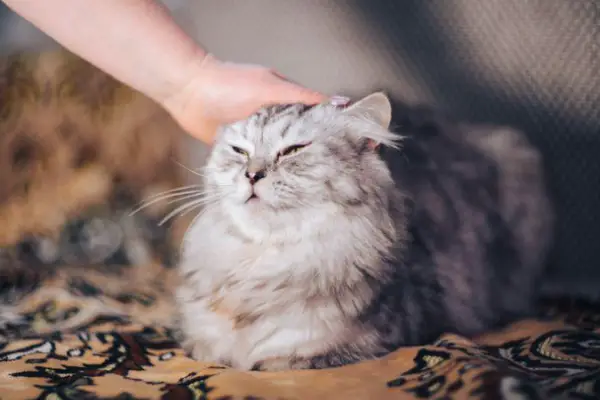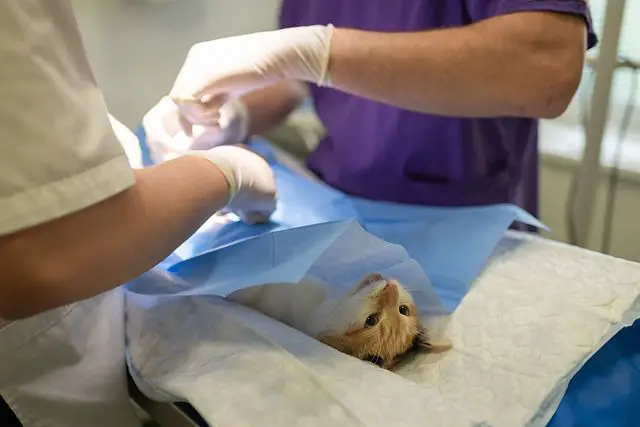Why Is My Cat So Aggressive With Other Cats [10 Reasons]
![Why Is My Cat So Aggressive With Other Cats [10 Reasons] Why Is My Cat So Aggressive With Other Cats](https://petcreeks.com/wp-content/uploads/2023/10/the-cat-3737295_640.jpg)
Why is my cat so aggressive with other cats? Let’s find out together…
Have you ever wondered why your feline friend turns into a hissing, growling ball of fury when they encounter another cat?
Well, you’re in luck because today we’re diving deep into the fascinating world of cat aggression.
Let’s uncover the reasons behind your cat’s feisty behavior and discover how we can help them find their inner zen. Ready? Let’s go!
Understanding Cat Aggression
Understanding cat aggression is essential for maintaining a harmonious relationship with your feline companion.
Aggression in cats can stem from fear, territoriality, redirected aggression, or pain.
Recognizing the triggers and body language associated with aggression can help prevent potential conflicts.
Providing a safe, enriched environment, regular play, and positive reinforcement can help manage and prevent aggressive behavior.
Consulting with a veterinarian or animal behaviorist is crucial for addressing severe or persistent aggression in cats.
Why Is My Cat So Aggressive With Other Cats
Cats can be aggressive towards other cats due to various reasons such as fear, lack of socialization, inappropriate introduction of a new cat, overcrowding, redirected aggression, play, and predation.
It is essential to identify the underlying cause of aggression to treat the problem successfully.
Before reintroducing cats, create a plan to minimize cat fighting triggers. Separating the cats from each other completely is the first step if one cat keeps attacking another cat.
Medical evaluation is necessary to rule out any abnormalities that may cause aggressive behavior.
Let’s break it down further…
Reasons Your Cat Is So Aggressive With Other Cats
![Why Is My Cat So Aggressive With Other Cats [10 Reasons] Reasons Your Cat Is So Aggressive With Other Cats](https://petcreeks.com/wp-content/uploads/2023/12/pexels-kelly-19390732.jpg)
Here are some of the common reasons your cat is so aggressive with other cats:
1. Lack of Proper Introduction
When cats are introduced to each other without a proper introduction, it can lead to aggression. Cats are territorial animals and rely heavily on scent to navigate their surroundings.
Without a proper introduction, they may perceive the new cat as an intruder encroaching on their territory. This can trigger defensive behavior such as hissing, growling, and even physical attacks.
A proper introduction involves a gradual process of scent exchange and controlled visual access. By allowing the cats to get familiar with each other’s scent before direct contact, they can establish a level of comfort and reduce the chances of aggression.
An abrupt introduction can create a stressful situation, making cats feel threatened and more likely to exhibit aggressive behavior towards each other.
2. Social Hierarchy Struggles
Cats have a natural instinct to establish a social hierarchy within their group. This hierarchy is based on factors such as age, size, and confidence.
When a new cat enters the household, it disrupts the existing social order, leading to power struggles and potential aggression.
The aggression seen in these situations is often a result of cats asserting dominance or defending their place in the social hierarchy.
They may engage in behaviors like chasing, swatting, and fighting to establish their rank within the group. This process can be particularly intense if the cats involved have strong personalities or if they are of the same gender.
3. Resource Competition
Cats are known for their strong territorial instincts, and this extends to their resources as well. Resources can include food, water, litter boxes, sleeping areas, and even attention from their human companions.
When cats feel that their resources are being threatened or invaded by another cat, they may display aggressive behavior as a means of protecting what they consider to be theirs.
Resource-related aggression can manifest as guarding behavior, such as growling or hissing when another cat approaches their food bowl or litter box. It can also escalate to more intense aggression, including physical fights over resources.
In multi-cat households, it’s essential to provide separate resources for each cat to minimize resource competition and reduce the likelihood of aggression.
4. Previous Trauma
Just like humans, cats can carry emotional scars from past experiences.
Cats that have experienced trauma, such as abuse or attacks from other cats, may develop fear or aggression towards other felines.
These cats may become hypervigilant and defensive, ready to fight or flee at the slightest perceived threat.
It’s crucial to approach cats with a history of trauma with patience and understanding. Gradual desensitization and counter-conditioning techniques can help them overcome their fear and aggression.
Creating a safe and predictable environment for these cats, with plenty of hiding spots and vertical spaces, can also reduce their stress levels and minimize aggressive behaviors.
5. Territorial Disputes
Cats are territorial animals by nature, and they like to claim certain areas as their own. When another cat enters their territory, it can trigger a defensive response.
This behavior is especially common in outdoor cats, where they must compete for limited resources such as food, shelter, and mates.
The resulting aggressive encounters can involve vocalizations, posturing, and even physical altercations as they establish boundaries and defend their turf.
6. Lack of Proper Socialization
Early socialization is crucial for cats to learn how to interact with others of their kind.
Kittens who have positive experiences with other cats during their early developmental stages tend to grow up to be more socially adept.
However, cats that have not been properly socialized may have difficulty understanding feline body language, vocal cues, and appropriate play behavior.
This can lead to misunderstandings, fear-based aggression, and overall tension when interacting with other cats.
7. Health Issues
Just like humans, cats can experience a range of health issues that can impact their behavior. Pain, discomfort, or illness can make a cat more irritable, anxious, or sensitive to its surroundings.
In such cases, a cat may become defensive or aggressive as a way to protect itself or communicate its distress.
For example, a cat with an undiagnosed dental issue may become aggressive when approached near its face, while a cat in chronic pain may lash out when touched.
8. Unneutered/Unspayed Cats
Sexual maturity and reproductive instincts can significantly influence a cat’s behavior.
Unaltered cats, particularly during mating season, can become more territorial, vocal, and assertive in their interactions with other cats.
Male cats may compete aggressively for the attention of female cats, while females may exhibit defensive behaviors to protect themselves and their potential offspring.
Neutering and spaying can help reduce these behaviors and contribute to a more harmonious feline social environment.
9. Fear and Insecurity
Cats may exhibit aggression towards other cats due to fear and insecurity. This can be triggered by various factors such as territorial disputes, unfamiliar environments, or past negative experiences with other cats.
In such situations, cats may resort to aggressive behavior as a means of self-protection or to establish dominance within their territory.
10. Overstimulation
Overstimulation can also lead to aggressive behavior in cats. When a cat becomes overstimulated, especially during play or interaction with other cats, it may respond aggressively as a way to release the excess energy or as a result of feeling overwhelmed.
Understanding a cat’s threshold for stimulation and providing appropriate outlets for their energy can help mitigate aggressive behavior in multi-cat households.
Addressing Cat Aggression Toward Other Cats
![Why Is My Cat So Aggressive With Other Cats [10 Reasons] Addressing Cat Aggression Toward Other Cats](https://petcreeks.com/wp-content/uploads/2023/12/kelly-e1u0YdAkh9k-unsplash.jpg)
From my years of experience living with cats, here is my personal opinion on dealing with aggression toward other cats.
Dealing with cat aggression between your feline friends can be tough, but there are several strategies to help ease the tension.
Firstly, try and understand the root cause by observing their behavior and identifying triggers. Once identified, create separate spaces for each cat to reduce territorial conflicts.
Then re-introduce them again gradually, using scent swapping and positive reinforcement to create a more harmonious environment.
Make sure each cat has their own space with separate food, water, and litter boxes to reduce competition.
Provide plenty of vertical space and hiding spots to give each cat a sense of security. Utilizing interactive play sessions with each cat can help release pent-up energy and reduce stress.
If the cat’s aggression persists, consider consulting with a veterinarian or animal behaviorist for additional guidance and support.
Remember, patience is key, and with consistent effort, you can help your cats coexist peacefully.
Learn more about cat behavior issues.
Frequently Asked Questions
How can I help my cat become less aggressive towards other cats?
To help your cat become less aggressive towards other cats, it’s important to create a calm and secure environment. Gradual introductions with positive reinforcement can be beneficial. Provide separate spaces for each cat, with plenty of hiding spots and vertical territory. Additionally, consulting with a veterinarian or a cat behaviorist can provide you with expert advice tailored to your specific situation.
Is it possible for my cat to ever get along with other cats?
Yes, it is possible for your cat to get along with other cats, but it may require time and patience. Some cats may never become best friends, but with proper introductions and a positive environment, they can learn to coexist peacefully. Each cat has its unique personality, and it’s important to respect their boundaries and preferences.
Could my cat’s aggression towards other cats be a sign of an underlying health issue?
Yes, sometimes aggression can be a symptom of an underlying health issue. Cats in pain or discomfort may display aggression as a defensive mechanism. It’s crucial to rule out any medical conditions by consulting with a veterinarian. They can conduct a thorough examination and provide guidance on appropriate treatment options if necessary.
Can neutering or spaying my cat help reduce their aggression toward other cats?
Neutering or spaying your cat can help reduce their aggression towards other cats, especially if the aggression is driven by hormonal factors. These procedures can help balance their hormones and reduce territorial instincts. However, it’s important to note that neutering or spaying alone may not completely eliminate aggression, and behavior modification techniques may still be necessary.
How long will it take for my cat to stop being aggressive towards other cats?
The timeline for reducing aggression in cats can vary depending on the individual cat and the circumstances. It may take weeks, months, or even longer for your cat to adjust and become more tolerant of other cats. Consistency, patience, and positive reinforcement are key. It’s important to remember that each cat is unique, and progress may be gradual.
Learn more about sudden aggression in cats.
Conclusion
In conclusion, if your cat is displaying aggression towards other cats, it’s essential to understand the underlying reasons behind this behavior.
By observing their body language, providing proper socialization, and seeking professional advice if needed, you can help your furry friend find peace and harmony in their feline relationships.
Remember, love and patience go a long way in resolving any cat conflicts.


![Why Do Cats Hang Around My House [9 Top Reasons] Why Do Cats Hang Around My House](https://petcreeks.com/wp-content/uploads/2023/10/arteida-mjeshtri-XoXHijkYhPo-unsplash.jpg)


![How to Keep Outdoor Cats Warm in Winter [10 Hints] How to Keep Outdoor Cats Warm in Winter](https://petcreeks.com/wp-content/uploads/2023/10/pexels-aleksandr-nadyojin-7335655.jpg)
